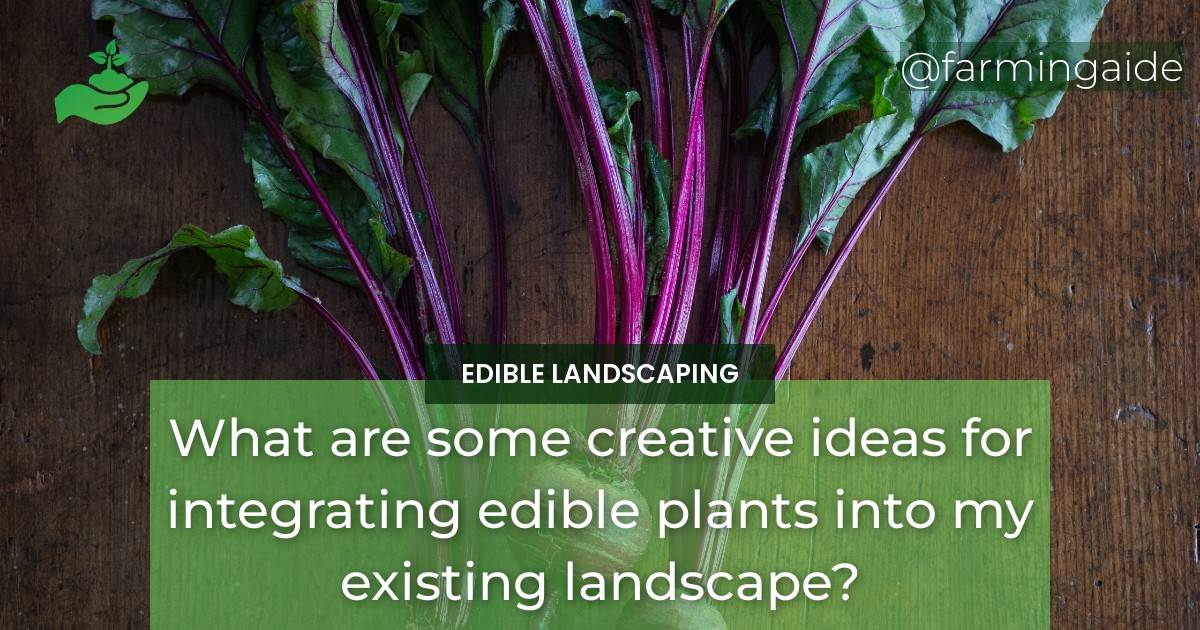Edible landscaping is a unique and innovative way of integrating edible plants into your existing landscape design. It allows you to have a sustainable food source while also beautifying your surroundings. There are many creative ideas for integrating edible plants into your existing landscape, which we will discuss in this article.
Mixing Edible and Ornamental Plants
Benefits of Mixing Edible and Ornamental Plants
Mixing edible and ornamental plants is a great way to create a beautiful and functional landscape. It provides a way to grow food while adding color and texture to your yard. It also attracts beneficial insects and pollinators.
Tips for Mixing Edible and Ornamental Plants
- Choose plants with similar growing conditions.
- Plant in groups for a more cohesive look.
- Consider the color and texture of the plants when choosing them.
- Choose plants that are easy to maintain.
- Integrate edible and non-edible plants in a way that makes sense for your landscape.
Edible Hedges or Borders
Benefits of Edible Hedges or Borders
Edible hedges or borders are an excellent way to create a natural, edible barrier around your property. They provide privacy while also providing food. They can also help to prevent erosion and improve soil quality.
Types of Plants for Edible Hedges or Borders
- Berries, such as raspberries or blackberries
- Fruit trees, such as apples or pears
- Herbs, such as rosemary or lavender
- Nut trees, such as hazelnuts or almonds
- Vines, such as grape vines or kiwi vines
Tips for Creating Edible Hedges or Borders
- Choose plants that grow well in your climate.
- Plant in a straight line for a more formal look or staggered for a more natural look.
- Prune regularly to maintain the desired shape.
- Provide support for vines to climb.
- Choose plants that are disease-resistant and low maintenance.
ALSO READ
Edible Containers
Benefits of Edible Containers
Edible containers are an excellent way to grow food in small spaces, such as balconies or patios. They are also ideal for those who want to move their plants around to different locations. They are easy to maintain and can be used year-round.
Types of Edible Plants for Container Gardening
- Herbs, such as basil or thyme
- Leafy greens, such as lettuce or kale
- Root vegetables, such as carrots or radishes
- Tomatoes or peppers
- Strawberries or blueberries
Tips for Growing Edible Plants in Containers
- Choose containers that are large enough for the plant to grow.
- Use quality soil and fertilizer.
- Water regularly, but do not overwater.
- Provide adequate sunlight.
- Choose plants that do well in your climate.
Composting for a Healthy Edible Landscape
Benefits of Composting in Edible Landscaping
Composting is an essential part of a healthy edible landscape. It provides a natural source of fertilizer and helps to improve soil quality. It also reduces waste and is environmentally friendly.
Tips for Composting in Edible Landscaping
- Choose a compost bin that fits your needs.
- Use a variety of materials, such as leaves, grass clippings, and food waste.
- Turn the compost regularly to help it decompose faster.
- Avoid adding meat or dairy products to the compost.
- Use the compost to fertilize your plants.
ALSO READ
Edible Landscaping Design Ideas
Incorporating Edible Plants into Your Landscape Design
Integrating edible plants into your landscape design can be a fun and creative process. It allows you to create a unique and functional space that reflects your personality and taste.
Tips for Designing an Edible Landscape
- Consider the amount of sunlight and shade in your yard.
- Think about the size and shape of the space you have available.
- Choose plants that are visually appealing and functional.
- Consider the soil quality and drainage in your yard.
- Research the plants you want to use to make sure they will grow well in your area.
Maintaining Your Edible Landscape
Tips for Maintaining an Edible Landscape
- Water plants regularly, but do not overwater.
- Prune plants as needed to maintain their shape and health.
- Monitor for pests and diseases and take appropriate action.
- Fertilize plants as needed.
- Harvest plants when they are ripe.
Common Issues with Edible Landscaping and How to Solve Them
- Disease or pest problems can be solved by using natural methods, such as companion planting or insect-repelling plants.
- Plant overcrowding can be solved by thinning out plants or transplanting them to a larger space.
- Over or under watering can be solved by monitoring soil moisture levels and adjusting as needed.
Harvesting and Using Your Edible Landscape
Tips for Harvesting Your Edible Landscape
- Harvest plants when they are ripe.
- Store harvested plants properly to prolong their freshness.
- Use harvested plants in a variety of recipes.
Ideas for Using Your Edible Landscape Harvest
- Cook with fresh herbs.
- Make salads with home-grown greens.
- Use fruits in desserts or smoothies.
- Preserve excess produce by canning or freezing.
Can I Use the Plants in Your Guide to Create a Unique Edible Landscape Design?
Yes, you can use the plants in our edible landscaping plants guide to create a unique and beautiful edible landscape design. Whether you want to include fruit trees, herbs, or vegetables, our guide provides comprehensive information on how to incorporate these plants into your landscape design.
Conclusion
Integrating edible plants into your existing landscape is a fun and innovative way to create a sustainable source of food while also beautifying your surroundings. By mixing edible and ornamental plants, creating edible hedges or borders, using edible containers, composting, designing your landscape, and maintaining your plants, you can create a functional and beautiful edible landscape that will provide you with fresh produce year-round.
RELATED ARTICLES:


